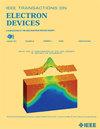Research on the Thermal Distribution Homogenization of High-Power Vertical-Cavity Surface-Emitting Lasers
IF 3.2
2区 工程技术
Q2 ENGINEERING, ELECTRICAL & ELECTRONIC
引用次数: 0
Abstract
To mitigate the central heat accumulation in vertical-cavity surface-emitting laser (VCSEL) arrays during operation, homogenize the temperature field distribution, and enhance the overall output power of the laser array, this article establishes a 3-D thermoelectric coupling physical model. The study investigates the impact of missing units at different positions within the array on thermal crosstalk and proposes an algorithm aimed at minimizing the difference in the array’s thermal coupling factor matrix. The effectiveness of this algorithm in homogenizing the array’s thermal distribution is verified through thermal simulations. Various array configurations with different layouts are designed and fabricated, and the power–current characteristics and spectral data of the devices before and after optimization are successfully obtained. For the optimized高功率垂直腔面发射激光器热分布均匀化研究
为了缓解垂直腔面发射激光器(VCSEL)阵列在工作过程中的中心积热,均匀化激光阵列的温度场分布,提高激光阵列的整体输出功率,建立了三维热电耦合物理模型。研究了阵列内不同位置缺失单元对热串扰的影响,提出了一种以最小化阵列热耦合因子矩阵差异为目标的算法。通过热模拟验证了该算法在均匀化阵列热分布方面的有效性。设计并制作了不同布局的阵列结构,成功获得了优化前后器件的功率电流特性和光谱数据。对于优化后的$3\ × 3$和$5\ × 5$阵列,峰值功率分别达到150.1和175.4 mW。光电转换效率比优化前分别提高了23.92%和13.63%。此外,优化后的阵列结构使波长红移分别减少了3.29 nm和1.24 nm。通过优化VCSEL阵列单元的布局,优化后的器件具有优异的热特性。
本文章由计算机程序翻译,如有差异,请以英文原文为准。
求助全文
约1分钟内获得全文
求助全文
来源期刊

IEEE Transactions on Electron Devices
工程技术-工程:电子与电气
CiteScore
5.80
自引率
16.10%
发文量
937
审稿时长
3.8 months
期刊介绍:
IEEE Transactions on Electron Devices publishes original and significant contributions relating to the theory, modeling, design, performance and reliability of electron and ion integrated circuit devices and interconnects, involving insulators, metals, organic materials, micro-plasmas, semiconductors, quantum-effect structures, vacuum devices, and emerging materials with applications in bioelectronics, biomedical electronics, computation, communications, displays, microelectromechanics, imaging, micro-actuators, nanoelectronics, optoelectronics, photovoltaics, power ICs and micro-sensors. Tutorial and review papers on these subjects are also published and occasional special issues appear to present a collection of papers which treat particular areas in more depth and breadth.
 求助内容:
求助内容: 应助结果提醒方式:
应助结果提醒方式:


